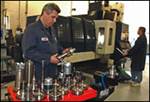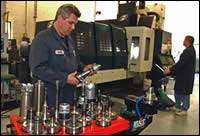The Design Consultant Option to Better Designs and Leadtimes
Tips and guidelines for establishing healthy and profitable relationships with design consultants.
Today’s marketplace demands short schedules and innovative designs that push the envelope on existing manufacturing techniques. This puts the molder and moldmaker in a great spot to aid the designer during the design process. Building a trusting relationship with design consultants can lead to a profitable relationship. Following is a list of tips for establishing that relationship.
Know What Each Side Wants
Remember that on some projects a design consultant may prefer to pre-select a moldmaker or molder in order to meet a tight schedule or to ensure they have specific technical skills. If you have specialized knowledge and techniques or a record for consistently delivering on short leadtimes, let design consultants know—you’ll be doing yourself and them a favor. Realize what makes your shop special and market those capabilities.
Show What You Can Do
When you or your reps call on design consultants, make sure you bring examples that highlight what differentiates you. Be upfront about typical leadtimes and costs. This information also can help the design consultant prepare clients for expected costs and leadtimes.
If after meeting you intend to leave parts behind, do so, but make sure your telephone and e-mail address are prominently placed on the item. Also, don’t hesitate to ask design consultants if they have any upcoming projects and take time to discuss their clients. There might be some synergistic overlap resulting in a win-win situation.
Offer to Review Designs
Even experienced designers like to run tricky tooling details by moldmakers long before the project will be quoted. Mold-makers don’t really have a lot of time to study an entire design, but they can usually comment on specific details quickly.
A design consultant should make sure its reviews are very concise and succinct. They usually expect the moldmaker to provide a professional opinion about very specific details. Ask design consultants to submit their questions in a concise way that can be reviewed easily, leaving no question to interpretation. The goal is to build a working relationship before the design is sent for quote. Then you will be familiar with the design and perhaps know where to save time and costs.
Know Your Client’s Designers
Design consultants have a list of preferred moldmakers and molders, who are the first people they call to review their projects and are part of the design consultant’s network. Be sure to ask customers who their designers are. This allows the moldmaker, molder and designer to establish a working relationship the client can rely upon. The moldmaker and designer also will learn each other’s capabilities—a trait that could influence the design process in a number of ways.
Know the Designer’s Knowledge and Experience
Some design consultants receive compliments from mold shops about the parts they design and how the products seldom require any changes. This, in great part, is the result of the design consultant knowing precisely what its designers can accomplish.
There is a range of skills and practices amongst design consultants and it’s important to understand these capabilities. If a design consultant is experienced, your life will be easier and the project may even require less time and effort. If they are not, you can help them understand what is expected and assure the end result meets your satisfaction.
You might want to develop a checklist of questions to ensure designers are correcting the design early on. Some design firms like working with moldmakers and molders that will take unfinished designs and solve all the molding problems. Others prefer moldmakers and molders that build exactly what they design. You just need to understand whom you’re dealing with and use them accordingly.
Change for the Right Reasons
Some moldmakers and molders try to change the appearance of a design in order to make it easier to build and gate. This is not the way to win over the design consultant. When a design consultant is hired to develop the look and feel of a product, they need to have a partner working from the same page. In today’s competitive market, the appearance of a product can often be the differentiating feature. Also, don’t turn the review process of an advanced design into major redesign.
However, do explain when a design has problems or may have cosmetic issues. Look for innovative ways to achieve the form, function and appearance. And, of course, if the design really has flaws don’t be afraid to explain why. If you let the designer know early about problems, they will thank you for your corrections, trust your opinions and rely on you again in the future.
Gating, Ejection, Moldflow
Designers sometimes address this issue last, after the entire design is completed, assuming the moldmaker and/or molder will figure out the best gate and ejection. This is where you can really differentiate your services and help the design consultant. Moldmakers and molders understand gating and ejection much better than the designers. Don’t hesitate to explain how you can achieve the stated goals and what techniques you have used successfully in the past. It always is best to get the gates, ejectors and mold flow approved by the consultant, preferably during the quote process.
Dimensions
Because many molds are built directly off a 3-D surface file there may not be clear dimensions, especially if the schedule is compressed. Always make sure you let consultants know of dimensional risks. All parties look bad if parts don’t look or function perfectly out of the mold. If you think a critical dimensional specification is missing, ask for it. Also, there are varying practices for tolerance clearance between parts. Some consultants build in all tolerance to parts, so moldmakers are not expected to modify the geometry. Others design line-to-line and expect the moldmaker and/or molder to figure out the tolerance. Avoid unwanted surprises by knowing exactly the practices of design consultants.
Closing a Project
The design consultant and client often work together to select the moldmaker and/or molder. Each project is different, so you should be direct in your discussions with design consultants. Ask who is going to make the final decision. If it is the client, ask to visit them, as well as the purchasing and engineering staff. Also, have the design consultant give some guidance on expected leadtime, part costs and tooling budgets. If you have prior experience that matches the project, be sure to supply parts for review by the consultant and client.
If leadtime is a particularly important and deciding factor, make sure you provide alternatives or even a range of prices based upon delivery. If piece price is most important, be sure to apprise the design consultant of any easy ways to reduce costs, such as substituting materials. Some consultants will make sure that molders asked to quote have a realistic chance to land a project; it’s a practice that all design firms should follow.
Materials Consulting
Design consultant engineers carefully select materials to meet stringent regula-tory and performance specifications, often
checking availability and costs, and, expecting moldmakers and molders to inform them before making substitutions. In an effort to reduce part costs or leadtimes, a client may sometimes ask a moldmaker and/or molder to substitute materials based on experience or availability. It is good practice to insist your design consultants approve the substitute. Clients sometimes don’t remember why a particular material was specified and may oversimplify the material requirements. Ambiguity on materials can lead to a lot of finger pointing later.
The International Question
Many projects require an integrated manufacturing solution, which means molded parts and molds may be moved to a contract manufacturer after initial pilot production, and that could be anywhere in the world.
Make sure design consultants you work with discuss their strategies. If a project is pre-determined to go to a continent you don’t serve, it may not be a good fit. However, don’t assume there is no opportunity. Ensure the design consultant and the client understands the overhead they will be taking on with offshore sources and the time that may be lost during first article production. Most design firms would rather spend time designing than traveling. If you are willing to build the mold and initial parts, and then ship these offshore, make sure that is clear.
Summary
Creating great new products is a team effort. Designs consultants are out front in this process and represent a direct link to moldmaking and molding opportunities. Your moldmaking knowledge and industry experience can be a great resource and lead to a mutually beneficial relationship that can bring about long-term success.
Related Content
Leading Mold Manufacturers Share Best Practices for Improving Efficiency
Precise Tooling Solutions, X-Cell Tool and Mold, M&M Tool and Mold, Ameritech Die & Mold, and Cavalier Tool & Manufacturing, sit down for a fast-paced Q&A focused on strategies for improving efficiencies across their operations.
Read MoreOEE Monitoring System Addresses Root Cause of Machine Downtime
Unique sensor and patent-pending algorithm of the Amper machine analytics system measures current draw to quickly and inexpensively inform manufacturers which machines are down and why.
Read MoreTop 10 Topics to Cover During an ISO 9001 Manufacturing Audit
Take a look at this practical hands-on approach to conducting a quality audit.
Read MoreThe Role of Social Media in Manufacturing
Charles Daniels CFO of Wepco Plastics shares insights on the role of social media in manufacturing, how to improve the “business” side of a small mold shop and continually developing culture.
Read MoreRead Next
Transforming a Modeling Tool Into a Collaborative Environment
Simultaneous product development and manufacturing represents a breakthrough in design team interaction—streamlining mold design.
Read MoreAre You a Moldmaker Considering 3D Printing? Consider the 3D Printing Workshop at NPE2024
Presentations will cover 3D printing for mold tooling, material innovation, product development, bridge production and full-scale, high-volume additive manufacturing.
Read MoreHow to Use Strategic Planning Tools, Data to Manage the Human Side of Business
Q&A with Marion Wells, MMT EAB member and founder of Human Asset Management.
Read More





















